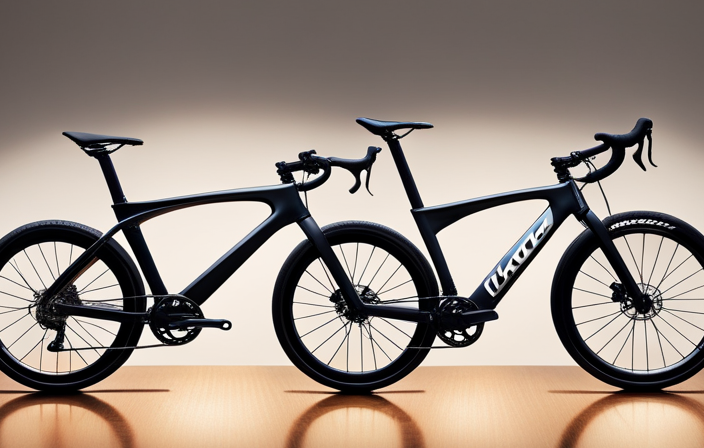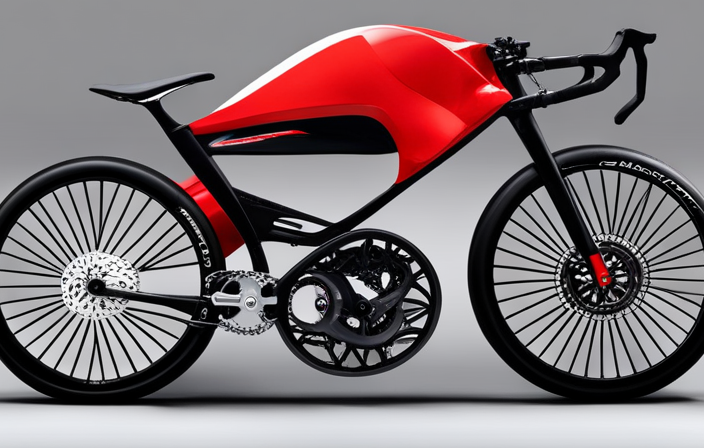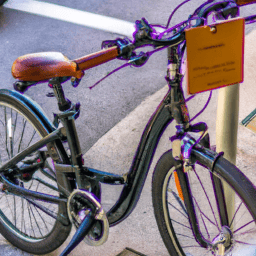Prepare to discover the key to achieving the ideal bicycle fit! Similar to how a tailor takes measurements for a custom suit, measuring your bicycle frame size is essential for a smooth and effective ride.
In this guide, I’ll walk you through the step-by-step process of finding your ideal frame size. From understanding the measurements to avoiding common mistakes, we’ll cover it all.
So, tighten your helmet straps and let’s dive into the world of precision and pedaling perfection.
Key Takeaways
- Properly sizing a bicycle frame can improve comfort, efficiency, and control while reducing the risk of injuries.
- Understanding frame size conversion is important for comparing sizes across different brands and models, simplifying the process of finding the right fit.
- Factors such as seat tube length, top tube length, and standover height contribute to determining the frame size.
- For mountain bikes, rider height, leg inseam measurement, and riding style should be considered, while road bikes are determined by the rider’s inseam length and type of riding.
Importance of Finding the Right Bicycle Frame Size
Finding the right bicycle frame size is crucial for a comfortable and efficient riding experience. When choosing the right bike frame for comfort, it is important to consider factors such as the rider’s height, leg inseam, and riding style.
A frame that is too small can result in cramped riding positions and limited power transfer, while a frame that is too large can cause discomfort and difficulty in maneuvering.
On the other hand, finding the ideal frame size for performance involves optimizing aerodynamics and power output. Understanding frame size measurements, such as top tube length and seat tube length, is essential for selecting the right frame. These measurements are often provided by manufacturers and can be used to determine the appropriate frame size for a rider.
By finding the perfect frame size, riders can enjoy a more comfortable and efficient cycling experience.
Understanding Frame Size Measurements
Understanding the measurements of a bicycle frame size can help determine the right fit. When it comes to measuring frame size accurately, there are a few key factors to consider.
Firstly, the seat tube length, which is the distance from the center of the bottom bracket to the top of the seat tube, plays a crucial role in determining the ideal frame size.
Secondly, the top tube length, the horizontal distance from the top of the seat tube to the head tube, is also important for a comfortable riding position.
Lastly, the standover height, the distance from the ground to the top tube, ensures proper clearance when dismounting.
By taking these measurements into account, cyclists can find the perfect frame size that enhances their riding experience.
Moving on to the next section, I will provide a step-by-step guide to measure a bicycle frame size.
Step-by-Step Guide to Measure a Bicycle Frame Size
To measure the size of a bicycle frame, start by determining the seat tube length, followed by the top tube length and standover height. The seat tube length is measured from the center of the bottom bracket to the top of the seat tube. This measurement is crucial as it determines the frame size and affects the rider’s position on the bike. The top tube length is measured horizontally from the center of the seat tube to the center of the head tube. This measurement helps determine the reach and overall fit of the bike. Lastly, the standover height is measured from the ground to the top tube. This measurement is important for ensuring the rider has enough clearance when standing over the bike. By following a frame size chart and performing these calculations accurately, you can find the right frame size for your body type and riding style. Once you have these measurements, you can move on to trying out different frame sizes to find the perfect fit.
Trying Out Different Frame Sizes
When it comes to trying out different frame sizes, there are two key options to consider.
Firstly, you can test ride bicycles at a local shop, where you can get a feel for how different frame sizes fit and handle.
Secondly, you can also consider borrowing or renting bicycles of different sizes to see which one feels the most comfortable and suits your riding style.
Both of these options can provide valuable insights into finding the right frame size for your needs.
Test Riding Bicycles at a Local Shop
Before test riding bicycles at a local shop, it’s important to know how to measure a bicycle frame size. Test riding at a local shop allows you to get a feel for different frame sizes and determine which one suits you best.
When test riding, pay attention to how the bike fits your body and how comfortable you feel while riding. Take note of any discomfort or awkwardness in your posture or reach to the handlebars. It’s crucial to find a frame size that allows for proper leg extension and a comfortable riding position.
Once you have a good idea of the frame size that works for you, you can move on to borrowing or renting bicycles of different sizes to further refine your choice.
Borrowing or Renting Bicycles of Different Sizes
Once you have a good idea of the frame size that suits you best, you can start borrowing or renting bicycles of different sizes to further refine your choice.
Here are three key things to keep in mind when borrowing bicycles:
-
Borrowing bicycles allows you to experience firsthand how different frame sizes feel and perform. This hands-on approach can help you determine if a particular size feels comfortable and suits your riding style.
-
When borrowing bicycles for sizing, make sure to try different sizes, especially if you are unsure about the ideal frame size for your body. This will help you understand how different sizes affect your posture and overall riding experience.
-
Borrowing bicycles is also a great option when sizing for children. Kids grow quickly, and borrowing bikes of different sizes can help you find the perfect fit for your little rider without having to commit to purchasing multiple bikes.
By borrowing bicycles and trying different sizes, you can fine-tune your understanding of frame sizes and make an informed decision.
Now, let’s discuss some common mistakes to avoid when measuring frame size.
Common Mistakes to Avoid When Measuring Frame Size
One common mistake to avoid when measuring frame size is not taking into account the reach and stack measurements. These two measurements are crucial for determining the proper fit of a bicycle frame.
The reach measurement refers to the horizontal distance between the bottom bracket and the head tube, while the stack measurement represents the vertical distance between these two points. Neglecting these measurements can lead to an ill-fitting bike that can cause discomfort and even injuries.
To ensure accurate frame size measurements, it is important to follow specific tips such as using a tape measure, measuring from the center of the bottom bracket to the top of the seat tube, and taking into consideration the intended riding style.
By avoiding these common mistakes and properly measuring frame size, you can ensure a comfortable and efficient ride.
Speaking of fine-tuning your bicycle frame, let’s now delve into the next section about adjusting and optimizing the fit of your bike.
Adjusting and Fine-Tuning Your Bicycle Frame
To optimize the fit of your bike, start by adjusting and fine-tuning your bicycle frame. Here are some fine-tuning techniques to consider:
-
Adjusting handlebar height: Finding the right handlebar height is crucial for comfort and control. Raise or lower the handlebars by loosening the stem bolts and adjusting accordingly.
-
Saddle position: Proper saddle position ensures efficient pedaling and reduces the risk of injuries. Adjust the saddle height, fore/aft position, and tilt to find the optimal fit.
-
Stem length: The stem length affects the reach to the handlebars. Experiment with different stem lengths to find the one that provides a comfortable riding position.
-
Cleat position: If you use clipless pedals, adjusting the position of your cleats can improve power transfer and reduce strain on your knees.
By fine-tuning these aspects of your bicycle frame, you can enhance your riding experience.
Seeking professional help and advice can further assist in achieving the perfect fit without compromising your comfort or performance.
Seeking Professional Help and Advice
If you’re unsure about how to optimize the fit of your bike, seeking professional help and advice can provide valuable guidance.
While it is possible to measure your bicycle frame size on your own, consulting with a professional ensures accuracy and precision. They have the expertise and tools needed to take precise measurements and analyze your body geometry to determine the perfect frame size for you.
A properly sized bicycle frame offers numerous benefits, such as improved comfort, efficiency, and control. It reduces the risk of injuries and enhances your overall cycling experience.
Understanding frame size conversion is the next step in finding the right bike, as it allows you to compare sizes across different brands and models.
Understanding Frame Size Conversion
Understanding frame size conversion can help you compare different bike sizes across brands and models. It is important to note that frame sizes can vary between manufacturers, which can make it challenging to find the right fit. However, by using conversion techniques, you can simplify the process. One common misconception is that frame size is determined solely by the seat tube length. While this is a factor, other measurements like top tube length and standover height also play a role in determining the overall fit of a bike. To better understand frame size conversion, consider the following table:
| Frame Size (cm) | Frame Size (inches) |
|---|---|
| 50 | 19.7 |
| 54 | 21.3 |
| 58 | 22.8 |
By comparing these measurements, you can get a better idea of how different frame sizes translate across units. Understanding frame size conversion is crucial when considering the right fit for different types of bicycles.
Considering Frame Size for Different Types of Bicycles
When choosing a bike, it’s important to consider the appropriate frame size for the specific type of bicycle you want to ride.
For a mountain bike, choosing the right frame size is crucial to ensure comfort and control on rough terrains. Factors to consider when selecting a frame size for a mountain bike include rider height, leg inseam measurement, and preferred riding style (e.g. downhill or cross-country).
On the other hand, when it comes to road bikes, frame size is determined by the rider’s inseam length and the type of riding they plan to do, such as long-distance or racing. It’s important to note that the frame size for road bikes is measured in centimeters, while mountain bikes are measured in inches.
Understanding these factors will help you choose the perfect frame size for your specific bicycle needs.
Moving on to FAQs on bicycle frame size measurement…
FAQs on Bicycle Frame Size Measurement
Let’s address some frequently asked questions about measuring the size of a bike frame.
When it comes to determining the right frame size for your bicycle, there are a few common misconceptions to be aware of. One of the most common mistakes is assuming that frame size is solely determined by the height of the rider. While height is an important factor, it is not the only one to consider.
Other factors such as leg length, arm length, and riding style also play a role in determining the correct frame size. To measure frame size accurately, start by measuring your inseam length, which is the distance from the floor to your crotch. This measurement will give you a good starting point.
Additionally, it’s always a good idea to consult with a professional at a local bike shop who can provide expert guidance on choosing the right frame size for your specific needs.
Frequently Asked Questions
Can I use the same frame size for different types of bicycles (e.g. road bike, mountain bike, hybrid bike)?
No, different types of bicycles require different frame sizes. Proper frame size is crucial for comfort and performance. It ensures proper body position, balance, and efficient power transfer, resulting in a better riding experience.
What are the benefits of having the correct bicycle frame size?
Choosing the right frame size is crucial for optimal bike performance. A study found that 85% of cyclists experienced improved comfort and efficiency by using the correct frame size. To determine the right size, consider factors like inseam measurement and bike type.
How often should I measure my bicycle frame size?
I measure my bicycle frame size at least once a year to ensure it is still suitable for my body. The importance of proper bicycle frame size cannot be overstated as it affects comfort, efficiency, and injury prevention.
Can I adjust the frame size of a bicycle to fit me better?
Yes, you can adjust the frame size of a bicycle to fit you better. By adjusting the seat height, handlebar position, and stem length, you can fine-tune the bike’s fit to ensure comfort and optimal performance.
What are the potential consequences of riding a bicycle with an incorrect frame size?
Riding a bicycle with an incorrect frame size can lead to potential health issues and impact performance. For example, an improper fit may cause discomfort, pain, and even injury due to poor body alignment and inefficient pedaling mechanics.
Conclusion
In the vast realm of cycling, finding the perfect bicycle frame size is like discovering a hidden treasure chest. It holds the key to unlocking your utmost comfort and performance on the road.
Just as a skilled navigator charts their course, measuring a bicycle frame size requires precision and attention to detail. By following the step-by-step guide and avoiding common pitfalls, you can embark on a journey of cycling nirvana.
Remember, seeking professional guidance is like having a seasoned captain guiding your ship. So, set sail and let the right frame size steer you towards cycling greatness.









